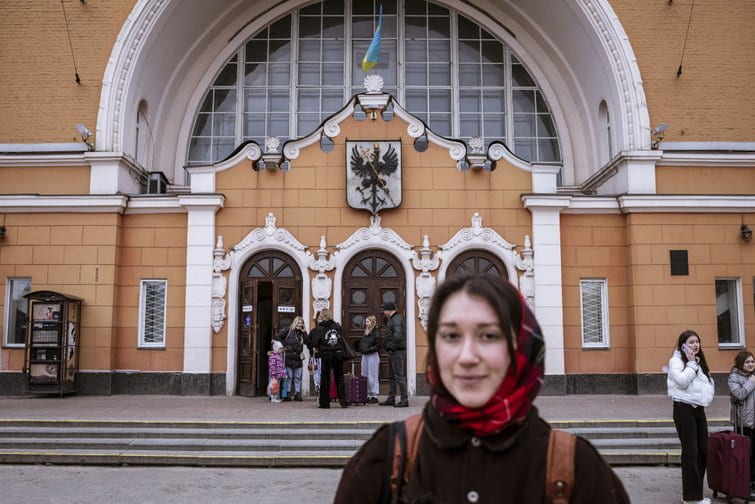Words by Yuliya Yurchenko
Ukraine was already one of the poorest and most indebted countries in Europe when Russia invaded Ukraine last year. It was at war, and had been since 2014 when Russia annexed Crimea and Russia-supported separatist proxies took control of parts of eastern Ukraine.
Since then, the country’s needs and losses have grown exponentially, its labour force has been dislocated, key infrastructure destroyed and the environment degraded.
The full scale of what it has lost will only be known after Russian troops totally withdraw, but within months of the invasion Ukraine laid out a $750bn ‘recovery plan’ for its postwar future. It cannot achieve this on its own. The state will probably struggle to finance or attract enough private investment for the recovery plan so large-scale international assistance is needed. Ukraine’s debts should be cancelled and there must be a shift towards letting the state lead its own redevelopment.
Promising plans for Ukraine’s recovery will be discussed at a high-level two-day conference in London on Wednesday next week. But they don’t match the scale of the problem. Here’s why.
Root and branch reform
It is vital to assess the root of Ukraine’s pre-war economic problems. In the process of Ukraine’s ‘market transition’ since 1991, it has suffered large scale de-development. Its economy, public services and infrastructure have deteriorated, having suffered from systemic and chronic underfunding.
This has resulted in, among other things, Ukrainian society and individuals stepping up to help plug the gaps once filled by state-funded services.
While Ukraine’s problems often get blamed on mismanagement, corruption and embezzlement, they have more to do with a combination of the ‘costs’ of pursuing reforms that are a pre-condition for closer integration with the European Union (EU), budgetary constraints, International Monetary Fund (IMF) conditions and similar limitations on fiscal policy choices. These would be a straitjacket for even the most well-meaning administrator, not just in Ukraine.
Cost of war
We should be clear about the financial costs of Russia’s war on Ukrainian society. Ukrainians lack access to adequate resources, including cash, caregiving services, childcare and suitable, long-term housing options. These are acute issues for displaced Ukrainians, just as much for those who stayed on in their homes after the Russian invasion. Real estate, particularly the rental market, is poorly regulated and the cost of renting in cities considered relatively safe as the war grinds on has soared. With schools and kindergartens being bombed, the education and care of children is extremely challenging. It doesn’t help that those sectors had pre-existing problems, from chronic underfunding and understaffing, to low wages and parents who struggled financially.
Sixteen months since the war began, jobs are being lost, savings depleted, credit cards maxed out. Many struggle to service their debts; many more will struggle to access credit now and in the future because it will be more expensive and more difficult to meet the criteria. Never mind the unfairness of household debt accumulation, this debt must be written off as part of the approach to Ukraine’s postwar recovery. After all, an economy cannot run on a mix of the goodwill of friends and relatives who get poorer by the day and sporadic local and foreign donations of food, medicine and clothes.

Internally displaced children playing in a temporary shelter in Lviv, in April 2023
|
Omar Marques / Getty Images
A new Marshall Plan
Ukraine’s extraordinary situation requires large-scale, multi-faceted international assistance, state and household debt cancellation and loans made on the implicit condition they facilitate state support and guidance of the economy.
So far, there have been discussions that revolve around Ukrainian reconstruction being modelled on the Marshall Plan. The original Marshall Plan, a key part of the funding of Europe’s post-Second World War restoration, was a success because it used a mix of cash grants and loans; and recipients had some discretion when it came to spending. European countries used the money to buy essential goods such as wheat and oil. Factories and housing were rebuilt. And the state was the key agent in rebuilding much of Europe, Japan and South Korea.
A similar plan for Ukraine would need to be designed and executed in alignment with the standards and best practice of EU labour rights, public services and environmental protection. By contrast, austerity is an uneconomical practice even in peacetime, let alone when a country is at war.
What is needed is the fully state-funded development of Ukraine’s public services and the care economy. One eye must be kept on the return on investment and this must become mainstream political discourse in Ukraine and among its international partners. Unlike common stereotypes, the Ukrainian state is not bloated. The IMF and other creditors will be needed as sources of financing, but it is Ukrainian state institutions that will implement the recovery plan. Therefore, the Ukrainian state should have “ownership of the reconstruction process”.
Moreover, the key role of civil society – NGOs and trade unions – must be acknowledged. The Ukrainian state, rather than international crowd-funders, must finance civil society initiatives by accepting that they may deliver where both the markets and the government have failed since 2014.
State support
As an institutional network, the state can rebuild Ukraine the way its people want and envisage. It can also build on the principles of deep sustainability reflected in the Lugano Recovery Plan, which emerged from last year’s international conference in Lugano, Switzerland to address Ukraine’s postwar reconstruction. This would mean regarding Ukraine’s economy as a socio-ecological system rather than a patchwork of economic fragments.
Ukraine will need green and low-carbon job creation. It will also need to support the care economy, arts, education, environmental preservation, and sustainable research and development. A just transition will maximise the chances of Ukraine’s economic self-sufficiency and reduced import dependence in key sectors. With the global economic policy consensus having shifted towards a post-Keynesian vision of state-led domestic investment, Ukraine’s local enterprises should have priority over their foreign rivals.
Here, job creation is crucial. Millions of Ukrainians work abroad seasonally and many more now have left the country because of the war and Covid. While money sent back home by overseas workers supports Ukraine’s economy, they are hardly an indicator of good quality of life for the average diasporic Ukrainian. Instead, they show the extent to which lives are destabilised. Conditions must be created for people to be able to return. Surveys, media reporting and anecdotal evidence all indicate that Ukrainians will return to Ukraine once it is safe and they have somewhere and something to return to.
EU integration could be the saving grace for Ukraine’s economy – yet also a force pushing the country’s further de-development, placing Ukraine on the edge of the European economic bloc. Lessons from other economically weak and new EU member states here are key. Research shows that integration processes are often a game rigged against EU periphery countries. But Ukraine’s situation is extraordinary, not least because its path to membership of the EU runs through the debris of a genocidal war, which began on the pretext that Moscow was threatened by Kyiv’s rapprochement with the EU and NATO.
An economy cannot run on a mix of the goodwill of friends and relatives who get poorer by the day and sporadic local and foreign donations of food, medicine and clothes
Even in peacetime, Ukraine’s demographic, economic, institutional and ecological tasks were enormous. The war has only intensified and deepened the challenges. For Ukrainian recovery to meet this challenge, we need to see a fundamental rewriting of the global debt and policy conditionality regime, which enforces austerity through international lending.
At the same time, the so-called ‘black holes; of offshore finance – tax avoidance and evasion – must be done away with so that a new political and financial settlement for developing states can be cobbled together. Many developing countries currently face the twin challenges of unmanageable debts and subservient relationships with international lenders.
The scale of what’s needed for Ukraine’s recovery means we need to think beyond Ukraine itself. We need to think about Ukraine as part of the global economy and what’s going to be required to build alternative economic systems for societies that have designed out wars, poverty and ecocide.
This article is based on a chapter of a new volume by the Foundation for Progressive European Studies, Europe and the War in Ukraine: From Russian Aggression to a New Eastern Policy. It will be launched at the University of Greenwich on 20 June.

